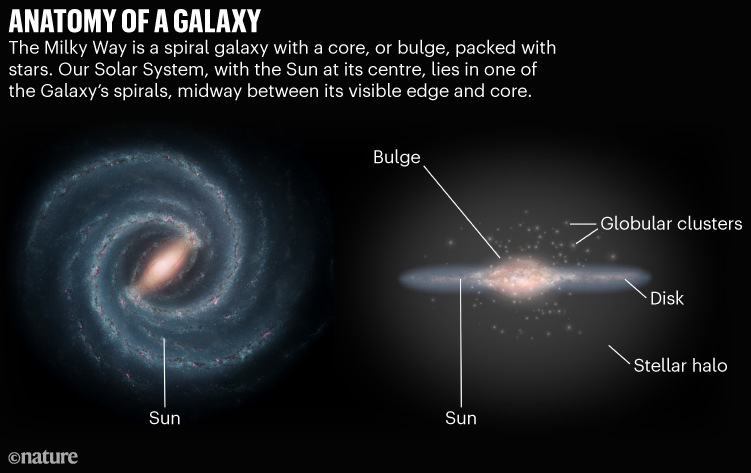The Milky Way is 'less weird' than we thought
NEWS
28 June 2024
The Milky Way is ‘less weird’ than we thought
The Galaxy’s core isn't as densely packed with stars as models suggested, a study finds, aligning it more closely with similar spiral galaxies.
By Sumeet Kulkarni
Our Galactic home just got a remodel. Peering through the dust and gas that intersperse our Galaxy, astronomers have found that the Milky Way’s core is less dense than originally thought.
This resculpting actually makes the Milky Way “less weird”, says Gail Zasowski, an astronomer at the University of Utah in Salt Lake City. The stars and other components of the Milky Way seemed more compact than those of galaxies similar to ours that scientists have been able to see and measure directly. The measurements made our Galaxy look “cute and small” in comparison, Zasowski says, “but you get a little suspicious” about why it is different.
Zasowski and her colleagues made their Galactic revision by measuring the locations and distances of almost a quarter of a million red giants — massive old stars — using survey data from the Apache Point Observatory Galactic Evolution Experiment (APOGEE). Normally, light from celestial bodies such as red giants can be obscured from the view of telescopes on Earth by interstellar dust, but the Apache observatory, in Sunspot, New Mexico, can detect near-infrared wavelengths, which pass through the dust. The researchers reported their findings on 27 June in Nature Astronomy1.
 Source: NASA/JPL-Caltech, ESA/ATG medialab
Source: NASA/JPL-Caltech, ESA/ATG medialab
[...]
======
https://www.nature.com/articles/s41550-024-02315-7
(preview/paywall)
Article
Published: 27 June 2024
The broken-exponential radial structure and larger size of the Milky Way galaxy
Jianhui Lian, Gail Zasowski, Bingqiu Chen, Julie Imig, Tao Wang, Nicholas Boardman & Xiaowei Liu
Nature Astronomy (2024)Cite this article
Abstract
The radial structure of a galaxy is a fundamental property that reflects its growth and assembly history. Although it is straightforward to measure that of external galaxies, it is challenging for the Milky Way because of our inside perspective. Traditionally, the radial structure of the Milky Way has been assumed to be characterized by a single-exponential disk and a central bulge component. Here we report (1) a measurement of the age-resolved Galactic surface brightness profile in a wide radial range from R = 0 to 17 kpc and (2) the corresponding size of the Milky Way in terms of a half-light radius. We find a broken surface brightness profile with a nearly flat distribution between 3.5 and 7.5 kpc, in contrast to a canonical single-exponential disk. This broken profile results in a half-light radius of 5.75 ± 0.38 kpc, significantly larger than that inferred from a single-exponential disk profile but consistent with that of local disk galaxies of similar mass. We also confirm that the size growth history of the Milky Way is broadly consistent with high-redshift galaxies but with systematically smaller size. Our results suggest that the Milky Way has a more complex radial structure and larger size than previously expected.
[...]
